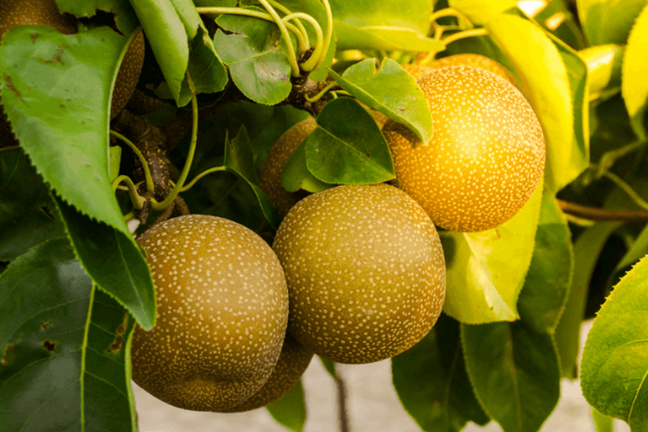Nashi (Pyrus pyrifolia), also known as Asian pears, have sweet and juicy crispy white flesh. They're delicious raw and can also be poached, sliced into salads and used in cakes, muffins and desserts.
The Australian Nashi Growers Association says that nashi were originally brought to Australia by Chinese goldminers in the 1850s. Many varieties have a round shape, similar to an apple, rather than being tear drop shaped like the common European pear. You'll often see nashi in supermarkets in individual mesh coverings to protect their delicate skin.

Winter is a fantastic time to plant a nashi at your place, while the trees are still dormant and leafless. Look for bare-rooted or potted plants in your local nursery. Growing to around 4 m tall and wide, they'll do best in a position with well-drained soil that receives at least 6 hours of sunshine a day. Nashi can also be espaliered, where the tree is trained to grow flat against a wall or trellis, taking up very little horizontal space. They have very pretty white bee-attracting flowers in spring, so they're both an attractive and productive tree.
Nashi prefer growing in cool and temperate climates however there are also 'low chill' varieties such as 'China' and 'Tropical Sunshu' that are suited to warmer areas. Some
nashi are self pollinating however others will need a pollinator to achieve a good harvest, so check the plant tag for your chosen variety to see what pollinating partner is recommended. European pears can often be an effective pollinator for nashi.
Nashi are harvested during autumn, when they're ripe and a light yellow-green colour. This differs to European pears, which should be picked while they're still hard and green.
It takes a lot of energy to produce all that delicious fruit. Apply some Yates Thrive® Natural Citrus & Fruit Organic Based Pelletised Plant Food around the root zone during periods of flowering, fruiting and new foliage growth to provide the tree with fast acting nutrients as well as organic ingredients that provide gentle slow release feeding and help to improve the quality of the soil.
Planting tip: when planting a new nashi tree, mix some Yates Dynamic Lifter into the planting hole. It will help improve the quality of the soil and provide the new tree with gentle slow release organic nutrients as it establishes.




